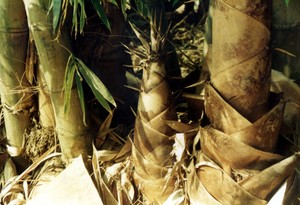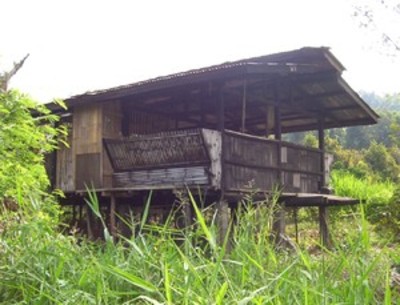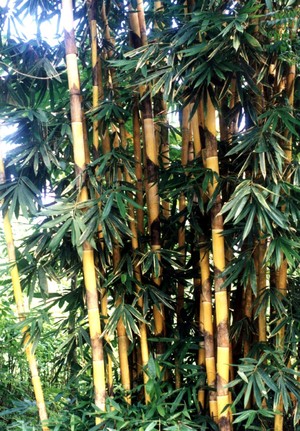Versatile bamboo poles.
Davao, 25 September 2009. “Notice that the stiffest tree is most easily cracked, while the bamboo or willow survives by bending with the wind,” the legendary martial artist Bruce Lee once said.
No wonder, most Asian cultures believe that humanity emerged from a bamboo stem. In the Philippines, for instance, legend tells that the first man and the first woman each emerged from split bamboo stems on an island created after the battle of the elemental forces (sky and ocean). In Malaysia, a similar legend tells of a man who dreams of a beautiful woman while sleeping under a bamboo plant; he wakes up and breaks the bamboo stem, discovering the woman inside.
Bamboo is known as the world’s tallest grass. But recently, it has received a new tag: “the grass of hope.” Although bamboo has been part of their art and culture, it was only recently that Chinese leaders took the plant seriously and is now building a massive bamboo industry.
Some years back, a Davaoeño reported that other Asian countries, the United States, and France were making a killing out of bamboo. “The tragedy here in the Philippines,” he said, “is that we have an abundance of bamboo but we don’t know much about. It is so common that we ignore its potentials. Other countries have already seen not only the beauty but the potentials of bamboo.”

Shoots - pickle em, then eat em.
But today, the Department of Environment and Natural Resources (DENR) is looking at bamboo in a different manner. “Bamboo is now recognized as the material of the millennium,” it said. “The versatility of bamboo proves to be of greater potential that the demand for the product continues to increase in terms of production and utilization. Aside from this, the international market demands more bamboo products that could help boost the flailing economy of our country.”
All over the globe, there are 91 genera and about 1,000 species of bamboo, generally known as kawayan in the Philippines. There are eight commercial species grown in the country and most of them can be found in Iloilo, Davao, Bukidnon and some parts of Luzon.
Bamboo, the most diverse group of plants in the grass family, is distinguished by a woody culm, complex branching, a generally robust rhizome system and infrequent flowering. Long known as the “poor man’s timber,” it is often listed as a “minor” forest product.
“Bamboo is not a weed, it’s a flowering plant. Bamboo is a magnificent plant,” commented Steve Lacy. Thomas Edison supposedly used a carbonized bamboo filament in his experiments in developing the light bulb. Alexander Graham Bell also used bamboo for his first phonograph needle. “You can eat, wear, and build with bamboo,” said Michael Block.

Handsome goat house, bamboo fashion.
The bamboo shoot (new bamboo culm that comes out of the ground) is food for many Asians. In the Philippines, they are made into pickles, fresh lumpia, or simply cooked with coconut and shrimps. In Thailand, bamboo salt seasoning and bamboo salt soybean paste can be bought in the public markets. The Taiwanese consume as much as 80,000 metric tons of bamboo shoots per year to make pickled bamboo shoots, one of their most popular fares.
Some of the most popular species of bamboo used for food are “kawayan tinik” (Bambusa blumeana), “bayog” (Dendrocalamus merrillianus), “bolo” (Gigantochloa levis), giant bamboo (Dendrocalamus asper), and “kayali” (Gigantochloa atter). Just a health warning: shoots of some species contain toxins that need to be leached or boiled out before they can be eaten safely.
“With the increasing awareness on the many health attributes and recipes one can make out of bamboo shoots, it is now gaining popularity within the broader population and in the global market,” reports Nimfa Torreta of the Department of Science and Technology. “There is also a worldwide interest on bamboo shoots because of the growing population of Asian ethnic origin around the world who have particular preference and taste for Asian food.”
Bamboo shoots have a huge potential for market. Export of bamboo shoot from Thailand in 1994 was pegged at US$29.50 million. Japan has a steady market of 250 tons per month while Australia imports 6,000- 12,000 tons of canned bamboo shoots annually.

Ornamental bamboo.
In terms of exports, the bamboo’s potential remains in the areas of furniture and handicrafts, whose global market grows at an annual average of US$8-billion. “We’re not talking here of raw bamboo for export, but finished products made from bamboo. From roots to tip, you can make soap, medicines, cosmetics, furniture, bricks, clothing, paper, floor tiles, wall panels, drinks, vegetables -- even surf boards from bamboo,” said Trade Undersecretary Merly Cruz.
Why is there a sudden craze for bamboo these days? “Bamboo is seen as a green product and a renewable resource in the developing world -- more and more buyers are taking a closer look at bamboo as raw material,” Cruz added.
The exports of bamboo furniture in the Philippines rose from US$625,000 to US$1.2 million in the mid-80’s until the mid-90’s. Both bamboo furniture and handicrafts racked up US$438 million from 1991 to 2000. Total exports of bamboo furniture in 2000 were recorded at only US$3.2 million.
There’s more to bamboo than just furniture and food. Its role in the construction field is equally substantial. Hundreds of millions of people live in houses made from bamboo. In Bangladesh, where 73% of the population live in bamboo houses, bamboo provides pillars, walls, window frames, rafters, room separators, ceilings and roofs. In Costa Rica, building with bamboo withstood earthquake which buildings with other materials were unable to.
Throughout rural Asia it is used for building bridges, from the sophisticated technology of suspension bridges to the simpler pontoon bridges. Bamboo scaffoldings employed on the high rise structures of Tokyo and Hong Kong. Building with bamboo in Costa Rica withstood earthquake which buildings with other materials were unable to.
Bamboo is also used for musical instruments of all three types: percussion or hammer instruments, wind instruments, and stringed instruments. TheBamboo Organ of Las Piñas has pipes made of bamboo culms. In Java, Indonesia, 20 different musical instruments have been fashioned of bamboo.
Capitalizing on this current trend and without much effort and capital needed, bamboo production could be a very promising livelihood opportunity for Filipinos. Some experts claim there is a lot of future in bamboo. Unfortunately, it is not as appreciated as yet in the country.
As trees are fast disappearing in various parts of the world and with the concern of environment growing, timber are getting scarce day by day. This is due to long period of time taken by even softwood to attain maturity. So, a substitute or if that is not possible, an alternative, has to be found. Bamboo is the answer for this.
Bamboos can be extensively grown in a wide range of habitats, from lowland to mountain forests in both dry and humid tropics, even on wastelands, swamps and dry or regularly flooded river banks.
The bamboo business is labor-intensive, especially during the first two years of operation. Studies have shown that labor alone accounts for roughly 90 percent of the total production cost. But the beauty of bamboo growing becomes more obvious after the first two critical growing years.
Bamboo matures in four to five years and growers and farmers can enjoy multiple harvests in the subsequent years. “If the bamboos survive,” says a bamboo grower, “you are assured of money for the next 30 to 50 years.”
Another good thing: the price of bamboo does not suffer from severe fluctuations unlike the prices of pork and chicken. In fact, they are priced depending on the diameter, volume, and distance traveled.
“It is a pity that we have neglected this important crop for so long,” laments Roy C. Alimoane, the director of the Davao-based Mindanao Baptist Rural Life Center (MBRLC) Foundation, Inc.
Photographs by Henrylito D.Tacio.
